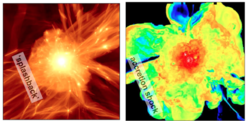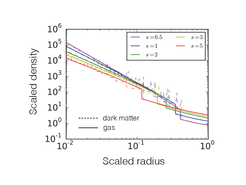At the edge of galaxy clusters: splashback and accretion shock
Observations are beginning to be sensitive enough to see the outskirts of galaxy clusters, where theory predicts interesting features in the dark matter and gas profiles: the so-called splashback and the accretion shock. Scientists at MPA use an analytical model to compute the locations of these features, and shed new light on the underlying physics.
Providing a simple model for complex cosmic phenomena is one of the goals of theoretical astrophysics. When successful, such a model yields a deeper understanding of the underlying physics. Recently scientists at MPA have done just this for better understanding what happens at the outskirts of galaxy clusters.
The observation of galaxy clusters has played an important role in convincing astronomers of the existence of dark matter: Galaxies inside galaxy clusters move with high velocities; hot, X-ray emitting gas fills the galaxy cluster region; often galaxy clusters show a gravitational lensing effect on background galaxies. All these measurements have consistently shown that visible matter is embedded in dark matter halos which make up about 85% of the total gravitating mass of a galaxy cluster.

Left: dark matter halo of a simulated galaxy cluster. The density steepening at the splashback is highlighted with a special image enhancement technique. Right: gas temperature of a simulated cluster. The accretion shock is clearly visible where the temperature steepens at the outskirts of the cluster.
Unlike a star, which is a 'halo' of gas with a clear boundary and a finite mass, these dark matter halos are fuzzy, extended structures. Their densities typically drop like ρ ∝ r-3 with radius in the outer regions without a clear cutoff, which has prevented astronomers to assign a definite boundary and mass to them. When you talk to an astronomer about a galaxy cluster with a certain mass, he or she will likely ask 'Within which radius is this mass defined?'
However, scientists recently realized that a particular feature at the outskirts of galaxy clusters can serve as a natural boundary for their dark matter halo. This feature - the so-called 'splashback' - marks the position of a sudden steepening in the density profile. Physically, this 'splashback' is caused by recently accreted dark matter that is piling up near the first apocenter of its orbit through the dark matter halo.
Hydrodynamical numerical simulations have found that the splashback radius closely tracks the position of the accretion shock. The accretion shock is located, where intergalactic plasma gets shock-heated when accreting onto a galaxy cluster. Also the accretion shock associated with a sudden steepening feature – this time in gas density and temperature. Since the physics underlying the splashback and the accretion shock is quite different, it is rather intriguing that they seem to track each other.
While simulations are a powerful tool for studying complex astrophysical systems, analytical models are also needed to simplify the picture and to understand the underlying physics. Using an analytical model called the 'self-similar spherical collapse model', scientists at MPA computed the growth of galaxy clusters in an expanding universe. The profile of a galaxy cluster and the history of its mass growth are treated in a consistent manner.

The analytical model captures the steepening features in the density profiles of dark matter (dashed line) and gas (solid line) in galaxy clusters, which correspond to the splashback radius and the accretion shock, respectively. The different colours show results for different cluster mass growth rates. In all cases, the locations of the splashback and accretion shock closely track each other.
This model can predict the radial locations of the splashback and the accretion shock as a function of the rate of cluster mass growth. Although both radii depend sensitively on the mass growth rate, they are found to indeed track each other. For typical mass growth rates for observed galaxy clusters, both quantities shrink at a higher mass growth rates, caused by different physics: For the gas, the inflowing material is associated with higher energy and momentum for a higher mass growth rate. Whereas for the dark matter, a significantly increased mass adds gravitational attraction to the splashback material.
A more intricate finding is that the locations of the splashback and the accretion shock track each other best if the adiabatic index of the gas is close to 5/3. Coincidentally, the intergalactic plasma, which is dominated by single atoms, has approximately this adiabatic index. In this sense, this tracking behaviour is not universal.
Improvements in the quality and quantity of observational data are bringing the outskirts of galaxy clusters into our view. Potential observational evidence for the splashback radius has already been found, and we may expect a direct detection of the accretion shock from X-ray and millimetre observations in the near future. Then, combining analytical predictions with those observations may lead to a deeper understanding and new discoveries of galaxy clusters and the structure assembly in our Universe.













